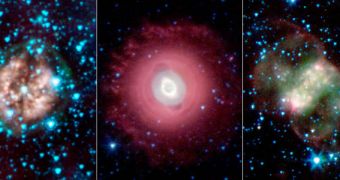To celebrate Halloween, researchers in charge of the Spitzer observing program have released an image of three cosmic ghosts, nebulae that showcase what our own Sun will look like once it reaches the end of its burning cycle.
The beautiful colors are produced by ultraviolet light emitted from the cores of dying stars, which energizes layers of materials that the stars ejected as their hydrogen reserves ran out.
The brain-like nebula on the left is called PMR 1, and is located roughly 5,000 light-years away from Earth, in the direction of the Vela constellation. Spitzer researchers say that the dying star is quickly losing its mass, which means that the light show will only get brighter from now on.
NGC 3242, or the Ghost of Jupiter nebula, appears in the middle image. Located a bit closer to home, at around 1,400 light-years away, this object showcases the concentric rings of materials that dying stars spew out, fueling the massive halo around them. The red colors in this image show the cooler, not the hotter, areas around the star.
The image on the right showcases the Little Dumbbell planetary nebula (NGC 650), located in the Perseus constellation, some 2,500 light-years away. The translucent green and red colors come from glowing hydrogen molecules, which are heated by intense stellar winds. The solid green areas in this image are the hottest in the nebula.
The Spitzer Space Telescope is managed by the Jet Propulsion Laboratory, in Pasadena, Ca., for NASA, through the California Institute of Technology (CalTech).

 14 DAY TRIAL //
14 DAY TRIAL //